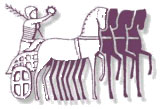Vespasian was born in AD 9 and was emperor from AD 69 until his death at the age of seventy. He founded the Flavian dynasty of the Roman empire and was famous for his military success as a general in the Roman army, and he commanded the Roman legion Legio II Augusta during the Roman invasion of Britain in AD 43.
A remarkable Emperor
He fought at the two first battles crossing the River Medway and the River Thames and, during the invasion overall, he is said to have fought 30 battles, taken 20 settlements and the Isle of Wight, and subjugated the Durotriges and Dumnonii tribes, all in the south-west. (Interestingly, the annual excavation on the site of a Durotrigian settlement in Dorset – the ‘Durotriges project’ – is underway now: you can read the site blog at https://microsites.bournemouth.ac.uk/big-dig/category/2015/.)
Vespasian became emperor in a military takeover after the suicide of the emperor Nero and ‘the year of the four emperors’. His remarkable legacy includes the archetypal amphitheatre, the Colosseum in Rome (AD 69), as part of his programme of restoration and improvement of the eternal city, which also included the new forum, the public baths and the Temple of Peace.
When he died, he was succeeded as emperor by his sons Titus and then Domitian, and so became the first Roman emperor to be directly succeeded by his own son. Titus provided public assistance after the destruction of Pompeii and Herculaneum by the eruption of Vesuvius in AD 79, and he and Domitian in turn contributed to the completion of the Colosseum.
Vespasian in Britain
Vespasian is, perhaps, most notable for his role in the history of Britain. He took part in the invasion of AD 43 and later, as emperor, he sent his own general Agricola back to extend and consolidate the Roman empire in Britain. Agricola was made consul and governor of Britannia in AD 77 and, from AD 78, he extended the province into modern Wales, the north and Scotland. According to Dr Barbara Levick, ‘Britain did more than engender Vespasian’s imperial career. As Emperor he in turn confirmed the position of Britain within the Empire…’ – at http://irisonline.org.uk/index.php/features/features-archive/215-vespasian-the-man-who-conquered-britain-then-rome . Perhaps most interestingly, it is possible that Vespasian actually helped the Roman general Plautius to capture Camulodunum (later Colchester) in AD 43 *, accompanied by the emperor Claudius, before he led Legio II Augusta off to tackle the south-west of the country.
The coins of Vespasian pay the ferryman
As emperor, Vespasian provided a good supply of bronze coins to Britain, from the imperial mint at Lyons in France, so coins of Vespasian are found quite often in Britain. A Roman ‘urn’ containing a coin hoard was once found at Bocking in Essex and, apparently, the hoard consisted mostly of coins of Vespasian. We have found quite a few coins of Vespasian on sites in Colchester, and they are good for dating features and stratigraphical sequences! In recent years, we have found several single coins of Vespasian in Roman burials on sites across the old garrison at Colchester, where they each seem to have been placed near the right hand of the deceased individual.
A couple of weeks ago, on the 12th June 2015, the item posted on this blog about the Colchester Archaeology Trust’s excavation of Colchester garrison Area E included a coin of Vespasian: this seemed to have been placed near the right hand of the deceased individual in the remarkable bustum burial and it gives the burial a precise date-range. The coin had been placed near the right hand of the deceased, presumably so that they could pay the ferryman to take them to the Underworld.
In 54 BC, it is recorded that Roman general Julius Caesar and his army invaded Britain and besieged a native Iron Age stronghold here: Trust director Philip has a theory that this was Camulodunum (later Colchester). The emperor Claudius came to Camulodunum during the Roman invasion of Britain in AD 43. It is possible that Vespasian was also at Camulodunum in AD 43.
If so, then Camulodunum – Colchester – can claim that three Roman rulers have visited here (ie one future dictator and consul of the republic plus one serving emperor and one future emperor of the empire). The question is, is this a record for a settlement in Roman Britain?!
* See Vespasian, by Dr Barbara Levick (1999); An archaeological history of Britain: continuity and change from prehistory to the present, by J M Eaton (2014); and To rule Britannia: the Claudian invasion of Britain, AD 43, by John Waite (2011).
Source: Colchester Archaeology Trust

![Vespasian aureus Fortuna: Classical Numismatic Group, Inc. http://www.cngcoins.com [GFDL (http://www.gnu.org/copyleft/fdl.html), CC-BY-SA-3.0 (http://creativecommons.org/licenses/by-sa/3.0/) or CC BY-SA 2.5 (http://creativecommons.org/licenses/by-sa/2.5)], via Wikimedia Commons Vespasian aureus Fortuna: Classical Numismatic Group, Inc. http://www.cngcoins.com [GFDL (http://www.gnu.org/copyleft/fdl.html), CC-BY-SA-3.0 (http://creativecommons.org/licenses/by-sa/3.0/) or CC BY-SA 2.5 (http://creativecommons.org/licenses/by-sa/2.5)], via Wikimedia Commons](http://www.bajrfed.co.uk/bajrpress/wp-content/uploads/2015/06/Vesp-696x464.jpg)
